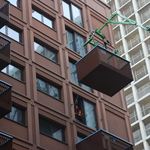salsa
Senior Member
What's to wow about? The TTC does not wow anyone.
and comparing Tonronto to KC, which has 460k people on 830km sq, is? We have 2.8 million on 630km sq.
KC transit serves the metropolitan area which is 2.4 million people. And toronto is not 2.8, it's 2.6. This comparison was not about being wowed by the TTC, but by the patheticness of KC transit. How about we compare KC to a much smaller city: London Ontario. Guess what, even London has higher transit ridership than KC. Let that sink in.





